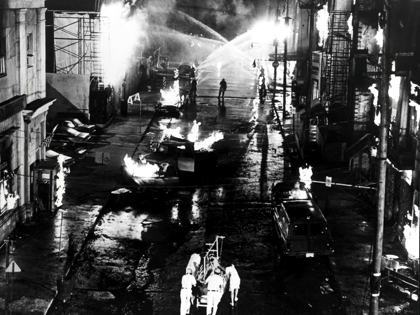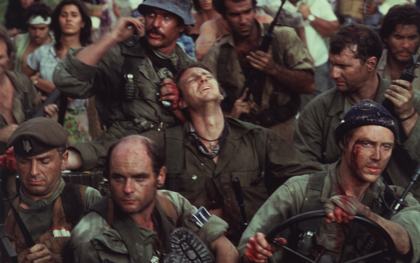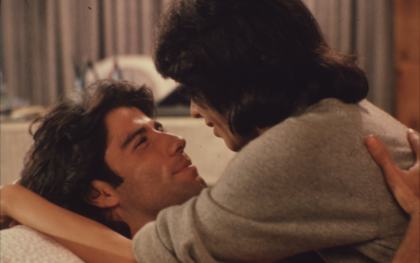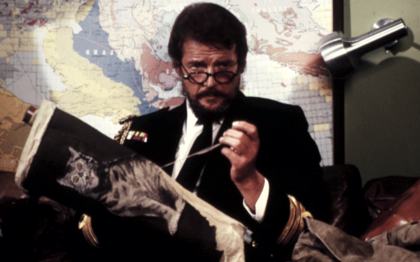The Gilbert Adair files
Early ‘Monthly Film Bulletin’ reviews
Editor’s note:
As a journal of record that undertook to cover every UK theatrical release, the Monthly Film Bulletin typically asked its neophyte contributors to cover films that they might not themselves have voluntarily submitted to, and Gilbert Adair accordingly interspersed critical analyses of Pasolini and Tarkovsky with snappier judgements on much less weighty fare. But the voice is unmistakable – indeed, the sublime ‘melancholic’ in the concluding sentence of And Give Us Our Daily Sex is arguably enough to render its author’s signature entirely superfluous.
— Michael Brooke
And Give Us Our Daily Sex (Malizia erotica)

José Ramon Larraz, 1980, Italy/Spain; reviewed in MFB November 1980, page 216
An inept if never unsalvageably bad sex comedy, whose meagre virtues include some possibly fortuitous echoes of Stolen Kisses, in the treatment of its adolescent hero, and Divorce Italian Style, in the faintly satirical portrait of his pompous, hair-netted father, as well as the exceptional beauty of the two lesbian nurses who, between them, rate at least ‘20’ on the Dudley Moore scale. For the English viewer, however, deprived of the adolescent hero’s long-awaited sexual baptism and beset by dubbing that goes to excruciating lengths in its doomed endeavours to synchronise Latin and Anglo-Saxon speech patterns, the degree to which José Larraz has capitalised on these assets must remain conjectural. The only scene of specifically cinematic interest is that in which Albert sneaks into a porn cinema: film-within-a-film distanciation being ingeniously effected by glimpses of grainy sex games even less competently shot than those of And Give Us Our Daily Sex itself. This allows Larraz to frame a handful of bored spectators in a head-on medium shot, momentarily confronting those of his own film with their melancholic mirror image.
City on Fire

Alvin Rakoff, 1979, Canada/US; reviewed in MFB February 1980, page 21
Paraphrasing the winning entry in a famous New Statesman competition for the dullest newspaper headline imaginable, the attractions of City on Fire may be encapsulated thus: Fire destroys city. Not many stars killed. Except that ‘dull’, as criticism, scarcely does justice to the ludicrous contrivance of this disaster movie (pace Henry Fonda’s closing remarks, it takes a quite extraordinary concatenation of circumstances to obtain the desired inferno). From a richesse d’embarras, its idiocy is best exemplified by the scene in which, as the crooked mayor and the jet-setting benefactress of a hospital resolve their amorous differences, the camera focuses on the beatific expression of an elderly patient who has finally managed to relieve himself into a bedpan.
Danger on Dartmoor
David Eady/Children’s Film Foundation, 1980, UK; reviewed in MFB June 1980, page 110
Although the basic situation may prove a trifle over-familiar to all but the smallest children, a script remarkably free of clichés (e.g., Patricia Hayes never once saying of her convict son “He’s a good boy”), an intelligent use of locations, and even the occasional idea that would serve in a higher-powered thriller (e.g. Louise converting Green to the straight and narrow with statistics from her pocket calculator) make for fifty-seven minutes without a single longueur. Nice performances all round, with a special mention to Demon.
The Dogs of War

John Irvin, 1980, UK; reviewed in MFB December 1980, page 233
If there were a lending library for films, The Dogs of War would always be out. Which means no more than that, though based on one of Frederick Forsyth’s lesser confections, it offers the precise cinematic equivalent of a best-selling political thriller, safely recommended for in-flight viewing. Much of the original’s appeal, of course, could be ascribed to the reader’s belief, judiciously fostered by all the attendant publicity, that the verisimilitude of its narrative had less to do with the usual creative processes than with the accumulation of inside information during a previous career ‘in Intelligence’, and it’s to the credit of John Irvin (a television director who rose to recent prominence with the BBC adaptation of Tinker, Tailor, Soldier, Spy) that surprisingly little of this conviction has been lost in transit.
The cool clarity of Jack Cardiff’s location photography proves an admirable substitute for the novel’s almost Balzacian wealth of background detail; the ‘Zangaron’ setting, complete with corrupt customs officer appropriating rather than merely accepting bribes, rings truer than most such mythical states; and the coup d’état, as painstakingly mapped out for our benefit as for the participants’, serves at each stage of its plotting (the purchase of weaponry from a London-based ‘import-export’ firm, the complex itinerary from England to West Africa, the careful tallying of all sums of money involved) to contribute to, not distract from, the build-up of suspense.
Completing the tableau is the requisite whiff of Boy’s Own Fascism, too diffuse to spoil our entertainment (especially as the mercenaries, turned renegade, opt improbably in the end to reinstate the country’s democratic leader) but tangible nevertheless in the complacent lingering over paramilitary hardware and the caricature of abject cowardice from the about-to-be-assassinated black President. The only element in any way disruptive to the smooth running of the machine is the unwarranted intensity of Christopher Walken’s performance: his tormented quivering makes him look incongruously at times like a transvestite whose wig has just been snatched off.
Moment By Moment

Jane Wagner, 1978, US; reviewed in MFB November 1979, pages 228-9
The plot-line of Moment by Moment is reminiscent of nothing so much as the May Irwin-John Rice Kiss of 1895, with narrative devices to match (Strip overhearing Trisha tell her gossipy best their affair is doomed, then rushing off into the night). Otherwise, it is little more than an animated snapshot of its leading man, baring body and soul to various effect: Travolta on the beach, Travolta at a gallery opening, Travolta in love, Travolta with a slight head cold – Travolta, in short, ad nauseam. As a result, Lily Tomlin and the film’s production values – a complacent reproduction of Californian opulence – are reduced to playing second and third fiddle respectively. Faced with the delicate question of visual style, Jane Wagner opts for the shot/reaction shot set-up with a rigour worthy of Bresson. Critics are fond of attributing a film’s badness to some hypothetical computer: this truly terrible movie might have been made by HAL in his most maudlin “Bicycle-built-for-two" mood, as the plugs were being pulled out.
North Sea Hijack

Andrew V. McLaglen, 1979, UK; reviewed in MFB April 1980, pages 73-4
With his cats, his Edwardian tweed suits and his Boy’s Own Paper intolerance of what he quaintly calls ‘females’, Rufus Excalibur ffolkes (sic sic sic) has to be the most tediously dotty hero in the canons of popular culture since Lord Peter Wimsey, the erstwhile champion. No amount of false whiskers and Blimpish gruffness, however, can eradicate the profound insipidity of Roger Moore’s screen presence, a perennial twinkle in his eye as sole proof that his tongue is in his cheek. Such eccentric coating on basically humdrum material is symptomatic of the film as a whole. Although numerous possibilities suggest themselves in the oil-rig setting, not least purely spectacular ones, McLaglen and his screenwriter have totally failed to exploit them, and the besieged platform, a magnificent set from what we can see of it, goes for relatively little. So cramped, in fact, is the framing of the rescue operation, by ffolkes’ commando of ffusiliers (sic), that it renders the unusual location virtually indistinguishable from a high-security prison, say, or the Tower of London. The one effectively felicitous trouvaille is the casting of Faith Brook as the Prime Minister, even if her filmy gowns and glamorous hair-do intimate something rather different from the home life of that office’s present incumbent.
David Thompson remembers Gilbert Adair in the February 2012 issue of Sight & Sound, on sale 3 January 2012
See also
Introduction: Michael Brooke introduces our Gilbert Adair tribute trove (December 2011)
The rubicon and the rubik cube: Adair on exile, paradox and Raúl Ruiz (Winter 1981/82)
Memories of youth, anticipations of maturity: Adair’s reviews of La Luna and The Outsiders (Winter 1979-80 and Autumn 1983)
One elephant, two elephant: Adair’s reviews of That Sinking Feeling and Gregory’s Girl (Summer 1981)
Meandrous expeditions: Adair’s reviews of Stalker and E.T.: The Extra-Terrestrial (Winter 1980/81 and Winter 1982/83)
Adair on music: reviews of Amadeus, Carmen and Ginger & Fred (Spring 1985, Spring 1986 and Monthly Film Bulletin March 1985)
The Nautilus and the nursery: Roland Barthes’s [sic] April-Fools paean to the Carry On cycle (Spring 1985)
Double takes: Heurtebise: Adair’s pseudonymous contributions to Sight & Sound’s Double Takes column (Winter 1984 to Summer 1985)
Favourites: select Adair celebrations of Jean Cocteau, Jean-Marie Straub and Danièle Huillet and Robert Bresson (Autumn 1981; Spring 1985; Summer 1987)
Gilbert Adair’s Top Ten films (September 2002)
The Dreamers reviewed by Ginette Vincendeau (February 2004)
